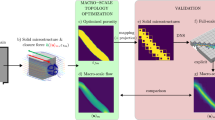Abstract
Hydromechanical fine blanking with fluid cavities of various shapes is investigated in this work. In this paper, seven shapes (V, angled, U, and four elliptical shapes) are studied. It is shown that the U-shape produces the greatest burnished length among the seven flow cavity shapes. Furthermore, the hybrid experimental optimization technique is used to optimize the parameters of the U-shaped cavity. It is found that the burnished surface obtained from this approach can nearly reach the full thickness of the blank in one operation, which means that the fracture zone can be almost entirely eliminated. In addition, the surface roughness of the burnished surface ranges between 0.5 and 0.098 μm, and the tolerance band for the diameter is between IT5 and IT7. These results represent an improvement over the values obtained with conventional fine blanking.
Similar content being viewed by others
References
Nakagawa T, Maeda T (1968) Experimental investigation on fine blanking. Sci Pap 62:65–80
Johnson R, Fogg B, Chisholm AW (1968) An investigation into the fine-blanking process. In: Proceedings of the 9th International Machine Tool Design & Research Conference Birmingham, England, 397–410
Lange K (1978) The potential of the fine blanking technique. Feintool AG Lyss, Switzerland, pp 1–6
Fukui S, Konda K, Maeda K (1971) Smooth shearing by stepped profile tool. Ann CIRP 20:57–58
Lee TC, Chan LC, Wu BJ (1955) Straining behaviour in blanking process—fine blanking vs conventional blanking. J Mater Process Technol 48:105–111
Morreale J, Marchand JL, Ronde Oustau F (1992) Development of a numerical code based on the slip-line field method: application to the fine-blanking process. J Mater Process Technol 31:393–411
Elyasi M, Daeizadeh V (2011) Effect of shape of workpiece on forming force in fine blanking process. Mater Res Innov 15:S386–S389
Slavič J, Bolka Š, Bratuš V, Boltežar M (2014) A novel laboratory blanking apparatus for the experimental identification of blanking parameters. J Mater Process Technol 214:507–513
Broek D (1971) A study on ductile failure, Ph.D. thesis, Delft University of Technology, The Netherlands; 1–114
Kasuga Y, Tsutsumi S, Mori T (1979) Investigation into shearing process of ductile sheet metals. Faculty of Engineering Nagoya University, Japan, pp 1–14
Dodd B, Bai Y (1987) Ductile fracture and ductility—with applications to metalworking. Academic Press, London
Yin F, Mao H, Hua L, Gu Z (2012) Back propagation neural network based calculation model for predicting wear of fine-blanking die during its whole lifetime. Comput Mater Sci 59:140–151
Hambli R, Reszka M (2002) Fracture criteria identification using an inverse technique method and blanking experiment. Int J Mech Sci 44:1349–1361
Rice JR, Tracey DM (1969) On the ductile enlargement of voids in triaxial stress fields. J Mech Phys Solids 17:201–217
Cockcroft MG, Latham DJ (1968) Ductility and the workability of metals. J Inst Met 96:33–39
Faura F, Garcia A, Estrems M (1998) Finite element analysis of optimum clearance in the blanking process. J Mater Process Technol 80–81:121–125
Hambli R (2001) Finite element simulation of fine blanking processes using a pressure-dependent damage model. J Mater Process Technol 116:252–264
Thipprakmas S, Jin M, Tomokazu K, Katsuhiro Y, Murakawa M (2008) Prediction of fine blanked surface characteristics using the finite element method (FEM). J Mater Process Technol 198:391–398
Hambil R, Richir S, Crublean P, Taravel B (2003) Prediction of optimum clearance in sheet metal blanking process. Int J Adv Manuf Technol 22:20–25
Klingenberg W, Singh UP (2006) Further observations and review of numerical simulations of sheet metal punching. Int J Adv Manuf Technol 30:638–644
Kwak TS, Kim YJ, Seo MK, Bae WB (2003) The effect of V-ring indenter on the sheared surface in the fine-blanking process of pawl. J Mater Process Technol 143–144:656–661
Padmanabhan R, Oliveira MC, Alves JL, Menezes LF (2007) Influence of process parameters on the deep drawing of stainless steel. Finite Elem Anal Des 43:1062–1067
Djavanroodi F, Pirgholi A, Derakhshani E (2010) FEM and ANN analysis in fine-blanking process. Mater Manuf Process 25:864–872
Wang JP, Huang GM, Lee HD, Chen CC, Chen TT (2013) Optimization of fine hydro-blanking. Steel Res Int 84:777–783
Wang JP, Huang GM, Chen CC, Yea YC, Chen TT (2013) Investigation of the shear-zone length in fine hydromechanical blanking. Int J Adv Manuf Technol 68:2761–2769
Wang YG, Li TF, Zhao MF, Lei JJ (2001) Discussion on the problems concerning function integration of building intelligent system. J Chongqing Inst Technol 15:5–10
Author information
Authors and Affiliations
Corresponding author
Rights and permissions
About this article
Cite this article
Huang, GM., Wang, JP., Chen, TT. et al. Optimal design for the fluid cavity shape in hydromechanical fine blanking. Int J Adv Manuf Technol 78, 153–160 (2015). https://doi.org/10.1007/s00170-014-6591-z
Received:
Accepted:
Published:
Issue Date:
DOI: https://doi.org/10.1007/s00170-014-6591-z




